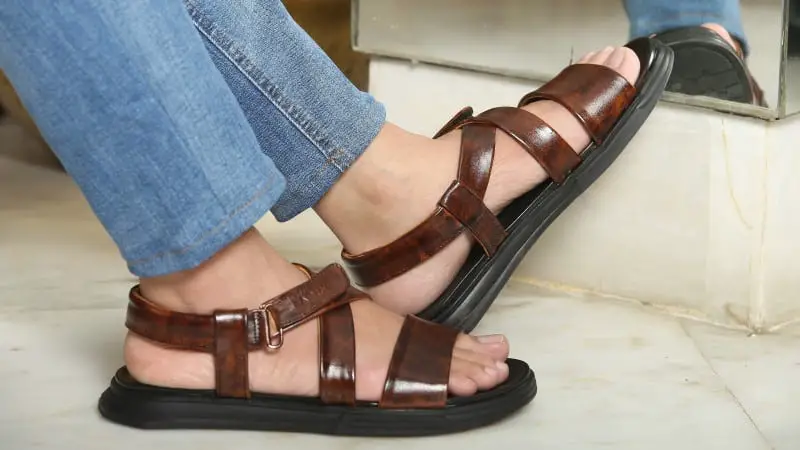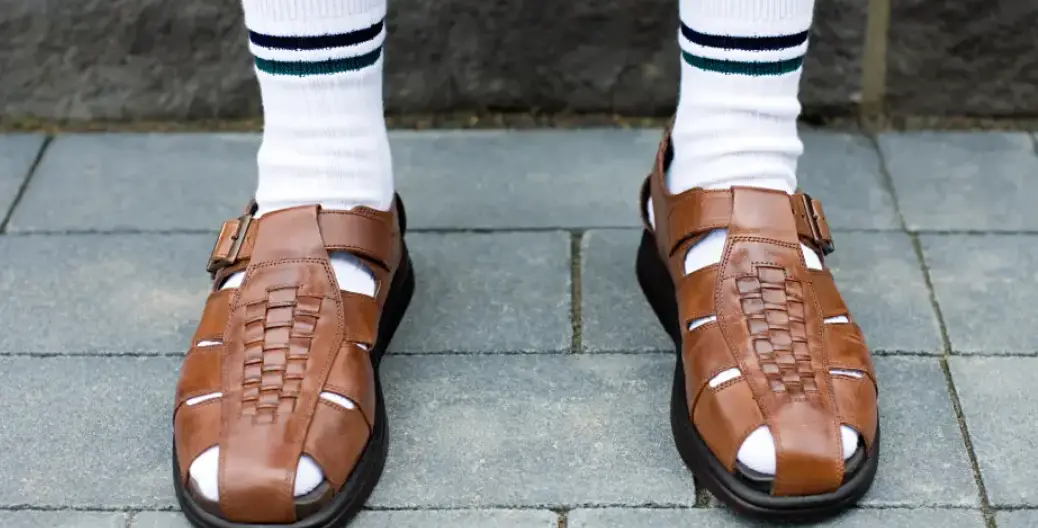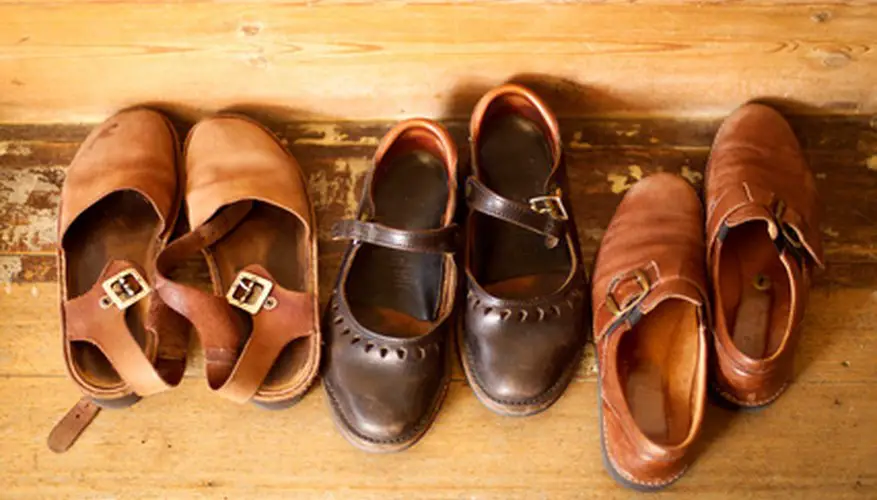Leather sandals are a timeless and classic footwear option that can last for years with proper care. Unfortunately, leather sandals can become stiff over time due to lack of use or improper storage. Thankfully, it is possible to soften leather sandals at home without requiring any special tools or products. This guide will provide you with the steps necessary to get your favorite pair of leather sandals feeling like new again!
Slowly Start Wearing Them

If your leather sandals have been stored away for a while and feel particularly stiff, one of the best ways to start softening them is by gradually wearing them. Put the sandals on for short periods at first and then increase the duration each day. This method will help make the leather softer with minimal effort.
Using A Hairdryer
One of the most effective and easiest ways to soften leather sandals is by using a hairdryer. All you need to do is wear your sandals while blowing warm air towards it from the hairdryer. The heat will cause the leather material to become more flexible, thus softening up the sandal. Please be careful not to point the hairdryer directly at one area of the sandal for an extended period of time as it may result in damage. Instead, ensure that you move it around in a consistent manner across all parts of the sandal. Make fingers away from the air stream to avoid getting burned, as it can become very hot.
Once you have completed the process, take off your sandals and let them cool down on their own. The leather should now feel much softer and more comfortable to wear.
Using Shoe Stretchers
A shoe stretcher is a device designed to help widen and enlarge the size of leather shoes. It can also be used to soften leather sandals. To use, insert the shoe shape into the corresponding hole in the stretcher and place it in your sandals. Securely attach the machine with screws, then begin widening it until you achieve the desired effect. Make sure to stop before you reach the maximum pressure, as this could damage your sandals. Once you’re done, take out the stretcher and wear your now softened leather sandals. You can also add suede or leather conditioner to keep them looking nice for longer. To make leather sandals more comfortable, you can use a shoe stretcher, which effectively softens them. Just make sure to use it with caution and follow the instructions carefully. [1]
Stretching With A Spoon
One of the most common methods for softening leather sandals is to stretch them using a spoon. The basis for this method rests on the fact that heat causes leather to become more malleable and elastic, so applying it in combination with pressure can help expand the material around your feet.
To start, make sure you have a spoon with a wide and rounded end. Fill a sink or bucket with warm water, then submerge the sandals for about 10 minutes until they are soaked.

Next, take the spoon and place it in between the straps of your shoe near where your toes begin to curl over them. Securely press down on the spoon while slowly twisting it from side to side. Keep doing this for a few minutes, until you feel the leather has become more supple and pliable.
Once finished, remove the sandals from the water and let them dry naturally. This should help your shoes fit much more comfortably!
Stuffing The Shoes With Newspaper
To keep your sandals in shape and make the leather more pliable, use newspaper to stuff them. Stuff the toes of the shoe with small pieces of crumpled paper, then fill up the rest of the shoe until it is filled to a comfortable level. Place them in direct sunlight for a few hours to help speed up the softening process.
Remove the newspaper and wear your sandals around the house or inside to break them in. This can take a few days, depending on how stiff they were in the beginning. You might need to repeat this process multiple times until the texture becomes as soft as desired.
These items can be bought from either shoe stores or online retailers. To make your sandals more comfortable, insert the shoe stretcher and keep it there for a few hours or overnight, which will help to soften the leather. When you are done stretching the shoes, remove the device and enjoy your newly softened leather sandals! [2]
Stretching With Oil

One way to soften leather sandals is by stretching them with oil. Begin by soaking a rag in warm water and then wringing it out so that it’s damp but not dripping wet. Rub the damp cloth over the entire surface of each sandal, making sure to saturate all of the leather. Once the sandals are sufficiently damp, it’s time to apply the oil.
The type of oil used is up to personal preference, though most experts agree that natural oils such as jojoba or neatsfoot work best. To treat the leather, use a cotton cloth to apply a small quantity of oil and massage the leather in circular movements.
Be careful not to over-saturate the leather, otherwise it could become too soft and damage easily. After the oil is thoroughly rubbed in, allow the sandals to sit overnight so that they can fully absorb the oil.
In the morning, put your feet into each sandal and wear them around for a few hours. Applying oil to the leather will soften and protect it, while also helping to stretch out any tight areas. You can ensure the longevity of your sandals while keeping them soft and comfortable with some careful handling.
Use A Stretching Spray
You can use a stretching spray or liquid solution to stretch out your sandals if they feel too tight. There are many different types of stretching sprays available in stores and online, so take some time to research which one would be best for your leather sandals.
Generally speaking, most leather-stretching solutions contain a combination of water, rubbing alcohol, and conditioning agents. To use it, spray the solution onto your sandals and let them sit for several hours or overnight. Then wear the sandals around your house until they have softened to your desired fit.

Continue repeating this process until you feel satisfied with how well your leather sandals fit. [3]
Using Rubbing Alcohol & Vaseline
To soften a pair of leather sandals with rubbing alcohol and Vaseline, you first need to make sure that the sandal is free from dirt or dust. If there is any debris, use a damp cloth to gently remove it. After you have cleaned your sandal, use a soft cloth to apply rubbing alcohol onto the leather and rub it in. Using this method will break down stiffening agents and initiate the softening process of the leather.
Once you’ve rubbed in the rubbing alcohol, take a small amount of Vaseline on your finger and massage it into the leather of your sandal. The Vaseline will act as a conditioner, helping to moisturize the leather and make it softer.
Walking Around In Your Shoes
While it is important to soften new leather sandals before you wear them, it’s usually a good idea to break the shoes in by walking around in them. This will help your feet become accustomed to the fit and shape of the sandals. Be sure that you don’t walk too far or for too long while wearing them; doing so can cause blisters and other damage to your feet.
As you walk around, pay attention to how the sandals feel on your feet.
You may need to try a few times before finding the ideal match.
Once you have found a comfortable fit, keep walking around in your sandals until they conform to your feet. This can take anywhere from a few days to a week or more depending on how often you wear them and how quickly the leather softens.
Getting Professional Help
If your leather sandals are hard to restore, it’s better to have them fixed by a professional cobbler. A professional cobbler will know exactly how to appropriately soften your sandals and can do so quickly with the right tools and materials. They should also be able to advise on any additional maintenance tips for your sandals.
Ultimately, if the sandals are a prized possession and you want them to remain in pristine condition for many years, professional help may be your best option. [4]
FAQ
How to make hard leather sandals soft?
You can soften hard leather sandals by using various techniques. The most commonly used method is to directly apply leather moisturizer or conditioner onto the item. Adding suppleness and flexibility back into the material, this process breaks down its fibers. You should also make sure that the material is entirely clean before applying any type of conditioner.
Additionally, there are some other methods you can use to make leather sandals soft. You can stuff them with paper towels and put them in a warm place like the oven or airing cupboard for several hours. Breaking down the fibers will make it softer. You can break down the fibers of your sandal using an old soft cloth by rubbing it over the sandal.
Finally, you can massage a little bit of lanolin or petroleum jelly into the leather and leave it to absorb overnight – this will help to make the item softer as well.
How can I soften my sandals?
Softening leather sandals is a very simple and straightforward process. The following steps will show you how to do it quickly and easily:
- To begin, use a damp cloth to wipe away dirt and debris from your leather sandals. This will help make the softening process easier later on.
- After the sandals have dried, you should apply a leather conditioner or cream to them. Applying this will help to maintain the flexibility of the leather and can greatly increase the lifespan of your sandals.
- Allow the conditioner or cream to absorb into the leather for 15-20 minutes before buffing it off with a soft cloth.
- To achieve the desired softness level, you might need to repeat this process a few times.
- Once you are satisfied with the result, treat your sandals with a waterproofing spray or cream to protect them from rain and moisture damage. Using this will help maintain their appearance for a longer period.
How do you soften stiff leather sandal straps?
To make stiff leather sandal straps more flexible, you can use a mixture of cold water and natural oils. To use cold water, dip a cloth in a bowl of cold water, squeeze out the extra water until the cloth is damp. Then, lightly rub the strap with the cloth all along its length. Using this will help eliminate any dirt or debris that may be stuck in the leather.
Apply a small amount of natural oil such as coconut or olive oil to the strap and work it into the leather with your fingertips or a soft cloth to add elasticity. Be sure not to over-apply, as too much oil can damage the material.
After waiting for 5-10 minutes, you can remove any leftover residue by polishing it off with a clean cloth.
This should make the leather strap softer and more flexible. Additionally, keep in mind that leather softens over time, so consider giving your sandals regular breaks from wear to help reduce stiffness.
You can also try using specialized leather conditioners or balms on your sandals to help soften leather and keep it in great condition. In some cases, certain styles of sandals or very stiff leathers may require replacement of the straps if all other attempts to fix them have failed. If you need to replace the straps on a pair of leather sandals, take them to a cobbler who specializes in shoe repair for professional assistance.
How long does it take to break in leather sandals?
Breaking in leather sandals may require a considerable amount of time. The time it takes for leather sandals to become soft and comfortable and conform to the shape of your feet depends on how often you wear them and your lifestyle. This can range from a few days to a few months. To break in your new sandals, begin by wearing them for brief periods of time and gradually lengthen the time you wear them over time.
If your leather sandals feel tight or stiff, you can use leather softeners or a damp rag to help loosen them up.
How long do leather sandals take to break in?
The length of time it takes to break in a pair of leather sandals depends on the type and thickness of the leather. Generally, thick leather will take longer to soften than thinner leather. Softening also tends to be faster if you wear your sandals often since constant use helps to naturally break them in. It can take anywhere from a few days to a couple of weeks for leather sandals to break in.
Do leather sandals soften over time?
Yes, leather sandals usually soften over time as you continue to wear them. The more you wear them, the easier it will become for your feet to fit into them without discomfort.
If your leather sandals feel stiff when you first get them, break them in gradually by wearing them for short walks and increasing the number of hours that you have them on. You can also use a few home remedies to help leather sandals soften up faster and make them more comfortable for your feet.
Does Vaseline soften leather?
Using Vaseline is an effective method for softening leather sandals. Petroleum jelly functions to lubricate and loosen the leather fibers of the sandal, resulting in increased comfort and reduced stiffness. To moisturize leather, apply a small amount of Vaseline to the dry surface and gently rub it in using circular motions. The Vaseline should be worked into the material until it is evenly distributed and has been absorbed by the leather. Once this is done, the sandals should feel softer and more pliable when worn.
Does olive oil soften leather?
I agree, olive oil is an effective method to make leather softer. It can be used on sandals and any other type of leather shoe or clothing item. If you want to use olive oil to make your sandals softer, you will need:
Clean clothes
Olive oil
To start, make sure that the sandals are clean and free of dirt and debris. After cleaning the area, put a small amount of olive oil on the leather surface using a cloth. Rub the cloth in gentle, circular motions for about five minutes. This will help soften and moisturize the leather. If you find that more oil needs to be applied, repeat this process until the desired softness is achieved. You may want to use a second cloth to buff and shine the leather once you are done.
Useful Video: Repairing a burn hole in leather
Conclusion
At the end of the day, softening your leather sandals is a simple process with lots of options. From treatments like mink oil and aloe vera to DIY solutions like freezing or stretching techniques, you can find an option that works well for your shoes. Taking the time to soften stiff leather sandals is a great idea as softer sandals are more comfortable to wear. Of course, if you still have any questions about how to soften leather sandals, be sure to consult with a professional shoe repair specialist.
References
- https://www.leatherskill.com/how-to-soften-and-break-in-leather-sandals/
- https://www.hoodmwr.com/how-to-soften-leather-shoes/
- https://www.wikihow.com/Make-Sandals-Comfortable
- https://www.timberland.co.uk/customer-care/product-faqs/how-to-stretch-and-soften-leather-footwear.html







Leave a Reply